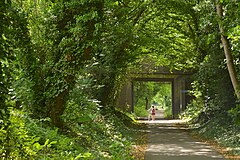Hatfield and St Albans Railway
 Cyclists on the Alban Way in May 2017 | |
| Overview | |
|---|---|
| Locale | Hertfordshire, England |
| Dates of operation | 1865–1968 |
| Successor | Abandoned |
| Technical | |
| Track gauge | 4 ft 8+1⁄2 in (1,435 mm) |
| Length | 6 miles 34.25 chains (10.35 km) |
Hatfield and St Albans Railway | |||||||||||||||||||||||||||||||||||||||||||||||||||||||||||||||||||||||||||||||||||||||||||||||||||||||||||||||||||||||||||||||||||||||||||||||||||||||
|---|---|---|---|---|---|---|---|---|---|---|---|---|---|---|---|---|---|---|---|---|---|---|---|---|---|---|---|---|---|---|---|---|---|---|---|---|---|---|---|---|---|---|---|---|---|---|---|---|---|---|---|---|---|---|---|---|---|---|---|---|---|---|---|---|---|---|---|---|---|---|---|---|---|---|---|---|---|---|---|---|---|---|---|---|---|---|---|---|---|---|---|---|---|---|---|---|---|---|---|---|---|---|---|---|---|---|---|---|---|---|---|---|---|---|---|---|---|---|---|---|---|---|---|---|---|---|---|---|---|---|---|---|---|---|---|---|---|---|---|---|---|---|---|---|---|---|---|---|---|---|---|
| |||||||||||||||||||||||||||||||||||||||||||||||||||||||||||||||||||||||||||||||||||||||||||||||||||||||||||||||||||||||||||||||||||||||||||||||||||||||
The Hatfield & St Albans Railway was a branch of the
History
Authorisation and opening
The Hatfield and St Albans Railway Company was incorporated by
The new line opened on 1 September 1865 with one planned intermediate station at Springfield (renamed Smallford in 1879), although this was not ready in time.[7] The Great Northern worked the line from the beginning and eventually absorbed the railway company on 1 November 1883.[8]
Operations
The initial weekday service consisted of eight trains in each direction from St Albans and

The Great Northern tried to counter the effect of the Midland, by running a few through coaches from St Albans to King's Cross but this did not last. It tried instead to foster local commuter traffic by timing the connections at Hatfield, so that services from St Albans,
Decline and closure
By the late 1930s, passenger numbers were declining in the face of increased competition from bus transport.[16] Passenger trains became uneconomic and in September 1939, following the start of hostilities, the LNER withdrew them. The needs of the de Havilland aircraft works at Hatfield however obliged the railway company to reopen the line three months later.[17] To facilitate access to the factory and to reduce the number of cars which would attract enemy attention, the LNER opened an unstaffed halt at Lemsford Road in 1942.[18] Passenger numbers fell back to their pre-war level once the war ended, and passenger services were again withdrawn in 1951.[1] The last passenger service on 28 September 1951 was the 5.08 from Hatfield, hauled by Class N7/1 No. 69644, which took 23 minutes to reach St Albans Abbey.[19]
Goods services continued for a further 18 years; two goods trains per day in each direction ran in the summer of 1963, carrying mainly coal for the St Albans gasworks.[20] The line continued to be unprofitable and general goods services were withdrawn on 5 October 1964. A weekly service continued until the end of the year to the Salvation Army siding in order to fulfil the contract, and banana trains ran to Butterwick siding when needed. As there was no traffic beyond this point, the rails were lifted from a point near Colney Lane Bridge to the junction with the Watford line. The remaining section of the line closed on 31 December 1968.[21] A contract with a scrap metal dealer at Smallford had meant that trains ran there until the end of 1968.[15]
The line today
After tracklifting in 1969, the councils of
The platforms at Hill End, Nast Hyde Halt and Lemsford Road Halt have survived,[23] as have the station buildings at Smallford.[24] London Road station is now a listed building.[16]
Gallery
These May 2017 photographs are ordered from the Hatfield end towards the St Albans end.
-
Remains of Nast Hyde Halt railway station
-
Nast Hyde Halt railway station platform
-
Sculptural arch on the Alban Way
-
Hill End Lane bridge
-
Bridge over Camp Road
-
Midland Railway bridge
References
- ^ a b Cockman 1983, p. 24.
- ^ Davies & Grant 1984, p. 58.
- ^ a b UK Retail Price Index inflation figures are based on data from Clark, Gregory (2017). "The Annual RPI and Average Earnings for Britain, 1209 to Present (New Series)". MeasuringWorth. Retrieved 7 May 2024.
- ^ Taylor & Anderson 1988, p. 6.
- ^ Taylor & Anderson 1988, p. 8.
- ^ Taylor & Anderson 1988, p. 9.
- ^ Oppitz 2000, p. 114.
- ^ Gordon 1990, p. 136.
- ^ Taylor & Anderson 1988, p. 55.
- ^ Oppitz 2000, p. 115.
- ^ Taylor & Anderson 1988, pp. 41–42.
- ^ Oppitz 2000, pp. 115–116.
- ^ Taylor & Anderson 1988, p. 47.
- ^ Oppitz 2000, pp. 116–117.
- ^ a b Davies & Grant 1984, p. 62.
- ^ a b Oppitz 2000, p. 117.
- ^ Taylor & Anderson 1988, p. 51.
- ^ Taylor & Anderson 1988, p. 17.
- ^ Taylor & Anderson 1988, p. 60.
- ^ Taylor & Anderson 1988, p. 60-61.
- ^ Taylor & Anderson 1988, p. 61.
- ^ a b Taylor & Anderson 1988, p. 64.
- ^ Davies & Grant 1984, p. 214.
- ^ Shannon 1996, p. 59.
Sources
- Cockman, F.G. (1983). The Railways of Hertfordshire. Stevenage, Herts: Hertfordshire Publications. ISBN 0-901354-24-4.
- Davies, R.T.; Grant, M.D. (1984) [1975]. Forgotten Railways: Chilterns and Cotswolds (Vol. 3). Newton Abbot, Devon: David St John Thomas. ISBN 0-946537-07-0.
- Gordon, D.I. (1990). A Regional History of the Railways of Great Britain: The Eastern Counties (Volume 5). Newton Abbot, Devon: David St John Thomas. ISBN 978-0-946537-55-6.
- Oppitz, Leslie (2000). Lost Railways of the Chilterns (Lost Railways Series). Newbury, Berkshire: Countryside Books. ISBN 978-1-85306-643-6.
- Shannon, Paul (May 1996) [1995]. British Railways Past and Present: Buckinghamshire, Bedfordshire and West Hertfordshire (No. 24). Wadenhoe, Peterborough: Past & Present Publishing Ltd. ISBN 978-1-85895-073-0.
- Taylor, Roger D.; Anderson, Brian (1988). The Hatfield and St Albans Branch of the Great Northern Railway (Locomotion Papers No. 168). Tarrant Hinton, Dorset: The Oakwood Press. ISBN 0-85361-373-7.
Further reading
- Goodman, F. (October–November 1908). "The Hatfield Branches of the Great Northern Railway". Railway Magazine.






